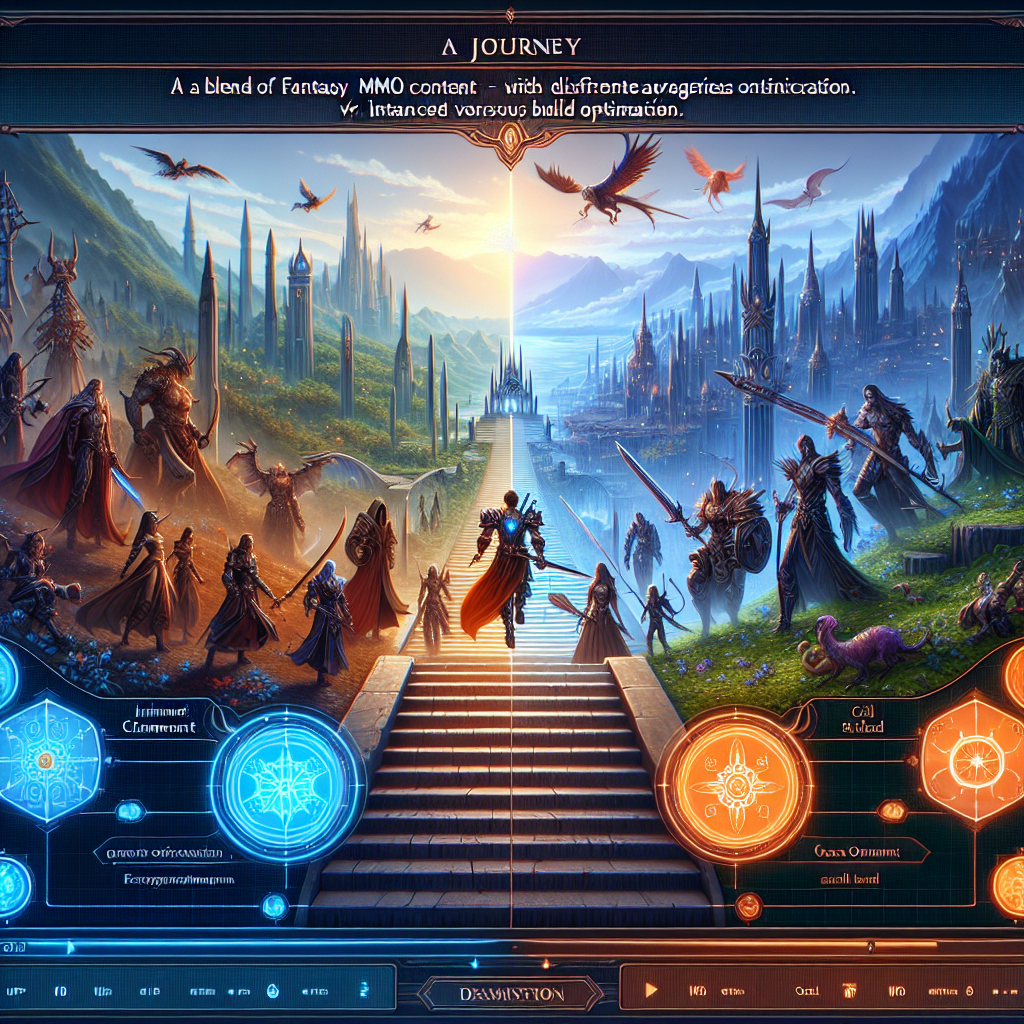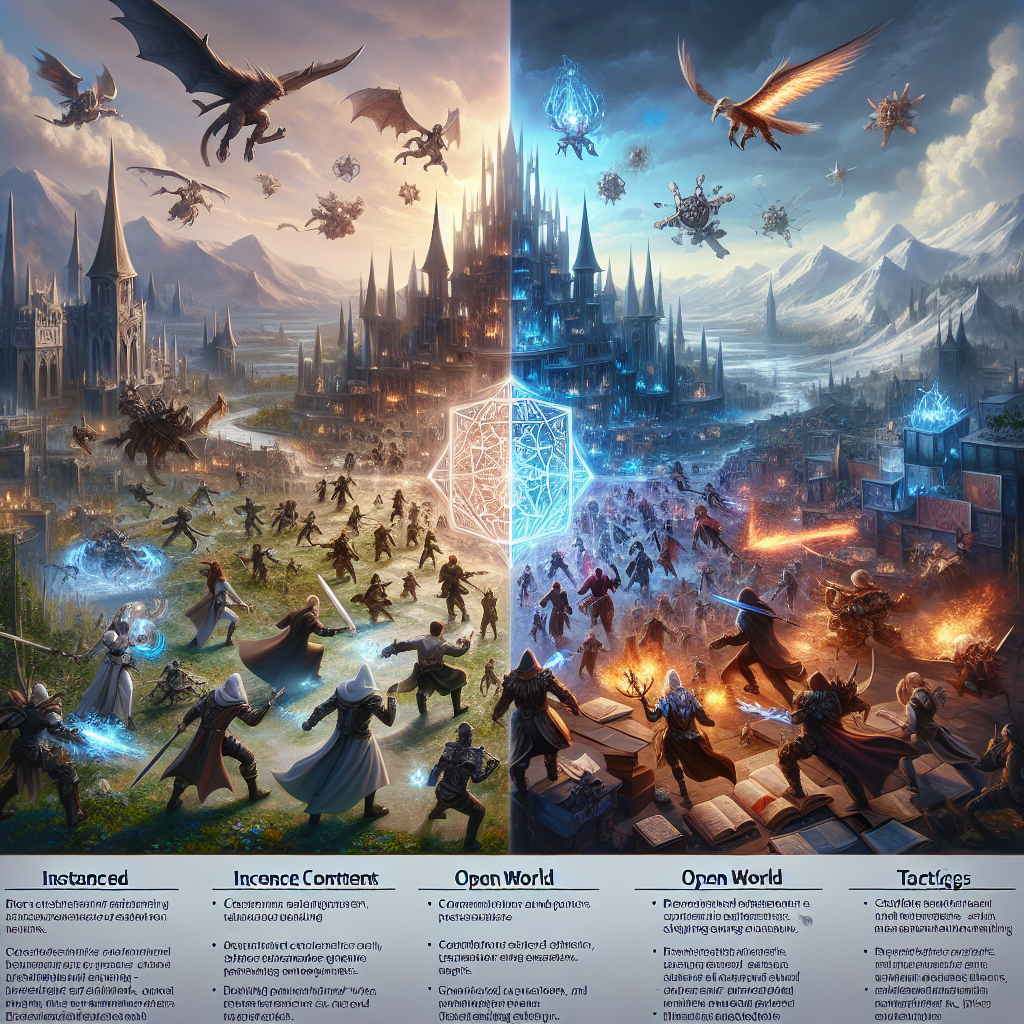Instanced vs Open World Content: Which Creates Better Experiences?
When it comes to game design, one of the fundamental choices developers face is whether to create instanced or open world content. Both approaches have their own unique advantages and disadvantages, and the decision can significantly impact the player experience.
In this comprehensive article, we'll delve into the intricacies of instanced and open world content, exploring the pros and cons of each approach, and ultimately determining which one tends to create better experiences for players.
Understanding Instanced Content
Instanced content refers to game environments or scenarios that are generated or replicated separately for each player or group of players. These instances are typically self-contained, separate from the main game world, and often tailored to specific objectives or challenges.
Key Characteristics of Instanced Content:
- Personalized Experience: Instanced content allows for a more personalized experience, as players can engage with the game world without interference or competition from other players.
- Controlled Difficulty: Instances can be designed with specific difficulty levels or challenges in mind, ensuring that players are presented with content that is appropriately tailored to their skill level.
- Replayability: Instanced content can often be replayed, allowing players to tackle the same challenges multiple times, either with different strategies or on higher difficulty levels.
- Narrative Focus: Instances can be used to deliver more focused, narrative-driven experiences, as the player's actions and progress within the instance are less likely to be impacted by outside factors.
Advantages of Instanced Content:
- Personalized Progression: Instanced content enables players to progress at their own pace, without being hindered or overshadowed by more experienced players.
- Streamlined Gameplay: Instances can be designed to eliminate distractions or irrelevant content, allowing players to focus on the core gameplay and objectives.
- Controlled Environment: Developers have more control over the instanced content, enabling them to fine-tune the experience and ensure a consistent level of quality.
- Scalability: Instanced content can be more easily scaled up or down to accommodate different player populations or hardware constraints.
Disadvantages of Instanced Content:
- Reduced Sense of Shared World: Instances can sometimes feel disconnected from the larger game world, potentially diminishing the sense of a cohesive, shared universe.
- Limited Interaction: Players within the same instance may have limited opportunities to interact with one another, reducing the social and collaborative aspects of the game.
- Potential for Repetition: If not designed carefully, instanced content can become repetitive or feel like a grind, as players may have to repeat the same challenges multiple times.
- Complexity in Design: Crafting engaging and meaningful instanced content can be more challenging for developers, as they must balance the unique requirements of each instance.
Exploring Open World Content
In contrast to instanced content, open world content refers to game environments that are persistent, seamless, and shared among all players. These worlds are typically vast, interconnected, and offer a high degree of freedom and exploration.
Key Characteristics of Open World Content:
- Immersive World: Open world games strive to create a sense of a living, breathing game world that players can freely explore and interact with.
- Non-linear Progression: Open world games often allow players to pursue objectives and quests in a non-linear fashion, enabling them to choose their own path and pace of progression.
- Emergent Gameplay: Open world environments can foster emergent gameplay, where unscripted events and player-driven interactions lead to unexpected and dynamic experiences.
- Shared Experiences: Open world games encourage social interaction and collaboration, as players can encounter and interact with one another in the shared game environment.
Advantages of Open World Content:
- Sense of Exploration: Open world games provide a greater sense of exploration and discovery, as players can freely navigate and uncover new areas, secrets, and surprises.
- Player Agency: Open world environments offer players more autonomy and decision-making power, allowing them to shape their own gameplay experiences.
- Emergent Gameplay: The unpredictable and dynamic nature of open world content can lead to unique and memorable experiences that foster player creativity and emergent gameplay.
- Shared Community: Open world games can foster a stronger sense of community, as players can engage in shared experiences, collaborate, and compete with one another within the same game world.
Disadvantages of Open World Content:
- Potential for Overwhelm: The vast and open-ended nature of open world games can sometimes be overwhelming for players, leading to feelings of being lost or unsure of where to focus their efforts.
- Balancing Challenges: Maintaining a consistent level of challenge and progression in an open world environment can be more challenging for developers, as players can access content in a non-linear fashion.
- Potential for Repetition: Without careful design, open world games can sometimes feel repetitive, as players may encounter similar types of content or activities across different regions of the game world.
- Performance Considerations: Rendering and maintaining a seamless open world environment can be more demanding on hardware and may require more advanced technical solutions to ensure a smooth player experience.
Comparing Instanced and Open World Content
Now that we've explored the key characteristics and considerations of both instanced and open world content, let's delve into a more in-depth comparison to determine which approach tends to create better experiences for players.
Player Engagement and Immersion
When it comes to player engagement and immersion, open world content generally has the advantage. The sense of exploration, freedom, and emergent gameplay inherent in open world environments can foster a deeper connection between the player and the game world. Players are more likely to feel invested in the world and their place within it, leading to a heightened sense of immersion.
In contrast, instanced content, while often more focused and tailored, can sometimes feel more disconnected from the larger game world, potentially reducing the player's sense of investment and immersion.
Narrative Delivery and Pacing
Instanced content often has an advantage when it comes to delivering more focused, narrative-driven experiences. The controlled nature of instances allows developers to craft tighter, more cohesive stories and quests, with a clearer sense of pacing and progression.
Open world games, while offering more freedom and non-linear progression, can sometimes struggle to maintain a consistent narrative flow, as players may encounter and engage with content in a more fragmented or non-linear manner.
Difficulty and Progression Management
Instanced content generally has an edge when it comes to difficulty and progression management. Developers can more easily fine-tune the challenge level of instances to match the player's skill and provide an appropriate level of engagement.
In open world games, maintaining a consistent difficulty curve and ensuring that players encounter content at a suitable level of challenge can be more challenging, as players can access different areas and content in a non-linear fashion.
Social Interaction and Collaboration
Open world content tends to foster more meaningful social interactions and collaborative experiences among players. The shared game environment encourages players to engage with one another, form communities, and work together towards common goals.
Instanced content, while not entirely devoid of social features, can sometimes feel more isolated and limit the opportunities for player-to-player interactions and cooperative gameplay.
Replayability and Longevity
Both instanced and open world content can offer strong replayability and longevity, depending on how they are designed and implemented.
Instanced content, with its potential for repeated challenges and tailored experiences, can provide a high degree of replayability for players seeking to master specific scenarios or test different strategies.
Open world games, on the other hand, can offer a more expansive and diverse range of content and activities, potentially leading to a greater sense of longevity as players continue to explore, discover, and engage with the world in new ways.
Balancing Instanced and Open World Content
While the comparison above highlights the strengths and weaknesses of each approach, the reality is that many successful games often strike a balance between instanced and open world content, leveraging the benefits of both to create a more holistic and engaging player experience.
Some examples of how games can effectively integrate both instanced and open world content include:
- Seamless Transitions: Blending instanced content with open world environments, allowing players to seamlessly transition between the two without disrupting the sense of immersion.
- Narrative Branching: Incorporating instanced, narrative-driven content within an open world framework, enabling players to engage with more focused storylines while still maintaining a sense of exploration and freedom.
- Complementary Gameplay: Designing instanced content to complement and support the open world experience, providing players with opportunities to engage in specialized activities or challenges that enhance their overall journey within the game world.
- Shared Social Spaces: Creating open world social hubs or community spaces where players can gather, interact, and participate in shared experiences, while still allowing for more focused, instanced content to exist within the larger game world.
By carefully balancing and integrating both instanced and open world content, developers can create a rich and multifaceted player experience that leverages the strengths of each approach while mitigating their respective weaknesses.
Key Takeaways
In conclusion, the debate between instanced and open world content in game design is a nuanced one, with both approaches offering unique advantages and disadvantages. The choice ultimately depends on the specific goals, target audience, and design vision of the game.
- Instanced content excels at providing personalized, narrative-driven experiences with a high degree of control and progression management, but can sometimes feel disconnected from the larger game world.
- Open world content fosters a stronger sense of exploration, player agency, and emergent gameplay, but can also be more challenging to balance and maintain a consistent level of challenge and progression.
- The most successful games often strike a balance between instanced and open world content, leveraging the strengths of each approach to create a more holistic and engaging player experience.
- Developers should carefully consider the target audience, desired gameplay experience, and overall design goals when deciding on the appropriate mix of instanced and open world content for their game.
Final Thoughts
Ultimately, the choice between instanced and open world content boils down to the specific needs and design goals of the game. By understanding the strengths and weaknesses of each approach, developers can make informed decisions that create the most compelling and engaging experiences for their players.
Whether you choose to focus on instanced, open world, or a balanced blend of both, the key is to ensure that the content aligns with the core vision and values of your game, and that it consistently delivers on the promises made to your players.





